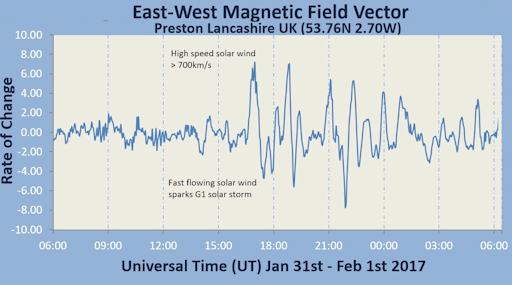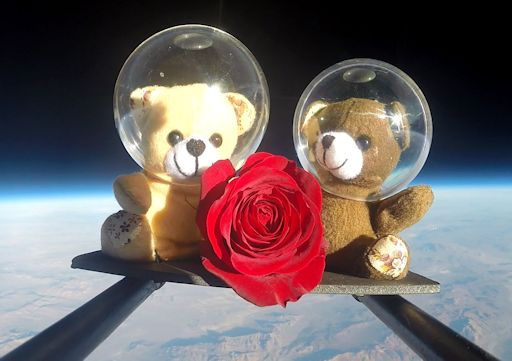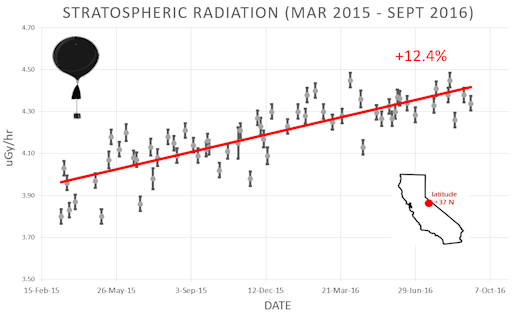Marianne's Arctic Xpress supports World Cancer Day by donating 50% of the price paid on all bookings Feb. 3-5 to cancer research. Arctic clothing and semi-pro cameras included. Groups of 2 to 8 welcome. Book Now | | | THE SOLAR WIND HAS ARRIVED: As predicted, a high-speed stream of solar wind hit Earth's magnetic field during the early hours of Feb. 1st. The impact literally rattled Earth's magnetic field (more on this below) and sparked bright auroras around the Arctic Circle. "Light night was bonkers," reports photographer Oliver Wright, who took this picture while leading an aurora photo tour in Abisko, Sweden: 
The solar wind stream that sparked this display is flowing from a large canyon-shaped hole in the the sun's atmosphere. It's a wide hole, and Earth should remain in the emerging stream for at least two more days. NOAA forecasters estimate a 40% to 60% chance of continued geomagnetic storms on Feb. 1-2. Free: Aurora alerts. What happens, exactly, when a solar wind stream hits Earth's magnetic field? Imagine yourself opening the door of your kitchen refigerator and finding a bowl of jello inside. Go ahead. Thump the surface. The jello vibrates. Earth's magnetic field behaves a bit like that jello when thumped by a solar wind disturbance. In the UK, Spaceweather.com reader Stuart Green operates a magnetometer that measures unrest in his local magnetic field. This plot from Jan. 31-Feb. 1 clearly shows the arrival of today's solar wind stream: 
"The predicted solar storm has arrived in the form of fast flowing solar wind, the result of which is twitching magnetometers around the globe, including my own here in the north-west of England," says Green. "There is no doubt from the data when exactly Earth entered the fast flowing wind stream." Vibrations in the magnetic field allow particles normally trapped in our planet's magnetosphere to rain down around the poles, igniting auroras. Magnetic unrest should continue tonight as Earth moves deeper into the gusty stream of solar wind. Realtime Aurora Photo Gallery
FAR-OUT VALENTINE'S GIFT: Did you know that cosmic rays are intensifying? That's just one of many results from the space weather ballooning program of Earth to Sky Calculus. The students receive no support from corporate sponsors or government grants. Instead, they are crowd-funded. Or rather ... bear-funded: 
Sales of Valentine's gifts like these space bears support our research. All proceeds support cosmic ray balloon launches and STEM education. Get a pair for yourself. They're only $79.95--including the rose, which has been pressed for safekeeping. Each adorable duo comes with Valentine's card showing the bears in flight and certifying their trip to the stratosphere. More out of this world gifts may be found in the Earth to Sky store. Realtime Space Weather Photo Gallery
Realtime Airglow Photo Gallery
Realtime Sprite Photo Gallery Every night, a network of NASA all-sky cameras scans the skies above the United States for meteoritic fireballs. Automated software maintained by NASA's Meteoroid Environment Office calculates their orbits, velocity, penetration depth in Earth's atmosphere and many other characteristics. Daily results are presented here on Spaceweather.com. On Feb. 1, 2017, the network reported 16 fireballs.
(16 sporadics)  In this diagram of the inner solar system, all of the fireball orbits intersect at a single point--Earth. The orbits are color-coded by velocity, from slow (red) to fast (blue). [Larger image] [movies] Potentially Hazardous Asteroids ( PHAs) are space rocks larger than approximately 100m that can come closer to Earth than 0.05 AU. None of the known PHAs is on a collision course with our planet, although astronomers are finding new ones all the time. On February 1, 2017 there were 1771 potentially hazardous asteroids. Notes: LD means "Lunar Distance." 1 LD = 384,401 km, the distance between Earth and the Moon. 1 LD also equals 0.00256 AU. MAG is the visual magnitude of the asteroid on the date of closest approach. | | Cosmic Rays in the Atmosphere |
Readers, thank you for your patience while we continue to develop this new section of Spaceweather.com. We've been working to streamline our data reduction, allowing us to post results from balloon flights much more rapidly, and we have developed a new data product, shown here: 
This plot displays radiation measurements not only in the stratosphere, but also at aviation altitudes. Dose rates are expessed as multiples of sea level. For instance, we see that boarding a plane that flies at 25,000 feet exposes passengers to dose rates ~10x higher than sea level. At 40,000 feet, the multiplier is closer to 50x. These measurements are made by our usual cosmic ray payload as it passes through aviation altitudes en route to the stratosphere over California. What is this all about? Approximately once a week, Spaceweather.com and the students of Earth to Sky Calculus fly space weather balloons to the stratosphere over California. These balloons are equipped with radiation sensors that detect cosmic rays, a surprisingly "down to Earth" form of space weather. Cosmic rays can seed clouds, trigger lightning, and penetrate commercial airplanes. Furthermore, there are studies ( #1, #2, #3, #4) linking cosmic rays with cardiac arrhythmias and sudden cardiac death in the general population. Our latest measurements show that cosmic rays are intensifying, with an increase of more than 12% since 2015: 
Why are cosmic rays intensifying? The main reason is the sun. Solar storm clouds such as coronal mass ejections (CMEs) sweep aside cosmic rays when they pass by Earth. During Solar Maximum, CMEs are abundant and cosmic rays are held at bay. Now, however, the solar cycle is swinging toward Solar Minimum, allowing cosmic rays to return. Another reason could be the weakening of Earth's magnetic field, which helps protect us from deep-space radiation. The radiation sensors onboard our helium balloons detect X-rays and gamma-rays in the energy range 10 keV to 20 MeV. These energies span the range of medical X-ray machines and airport security scanners. The data points in the graph above correspond to the peak of the Reneger-Pfotzer maximum, which lies about 67,000 feet above central California. When cosmic rays crash into Earth's atmosphere, they produce a spray of secondary particles that is most intense at the entrance to the stratosphere. Physicists Eric Reneger and Georg Pfotzer discovered the maximum using balloons in the 1930s and it is what we are measuring today. | | The official U.S. government space weather bureau | | | The first place to look for information about sundogs, pillars, rainbows and related phenomena. | | | Researchers call it a "Hubble for the sun." SDO is the most advanced solar observatory ever. | | | 3D views of the sun from NASA's Solar and Terrestrial Relations Observatory | | | Realtime and archival images of the Sun from SOHO. | | | from the NOAA Space Environment Center | | | a proud supporter of science education and Spaceweather.com | | | the underlying science of space weather |  | Beautyz for top beauty products reviews and their buying guides | | | These links help Spaceweather.com stay online. Thank you to our supporters! | | 
